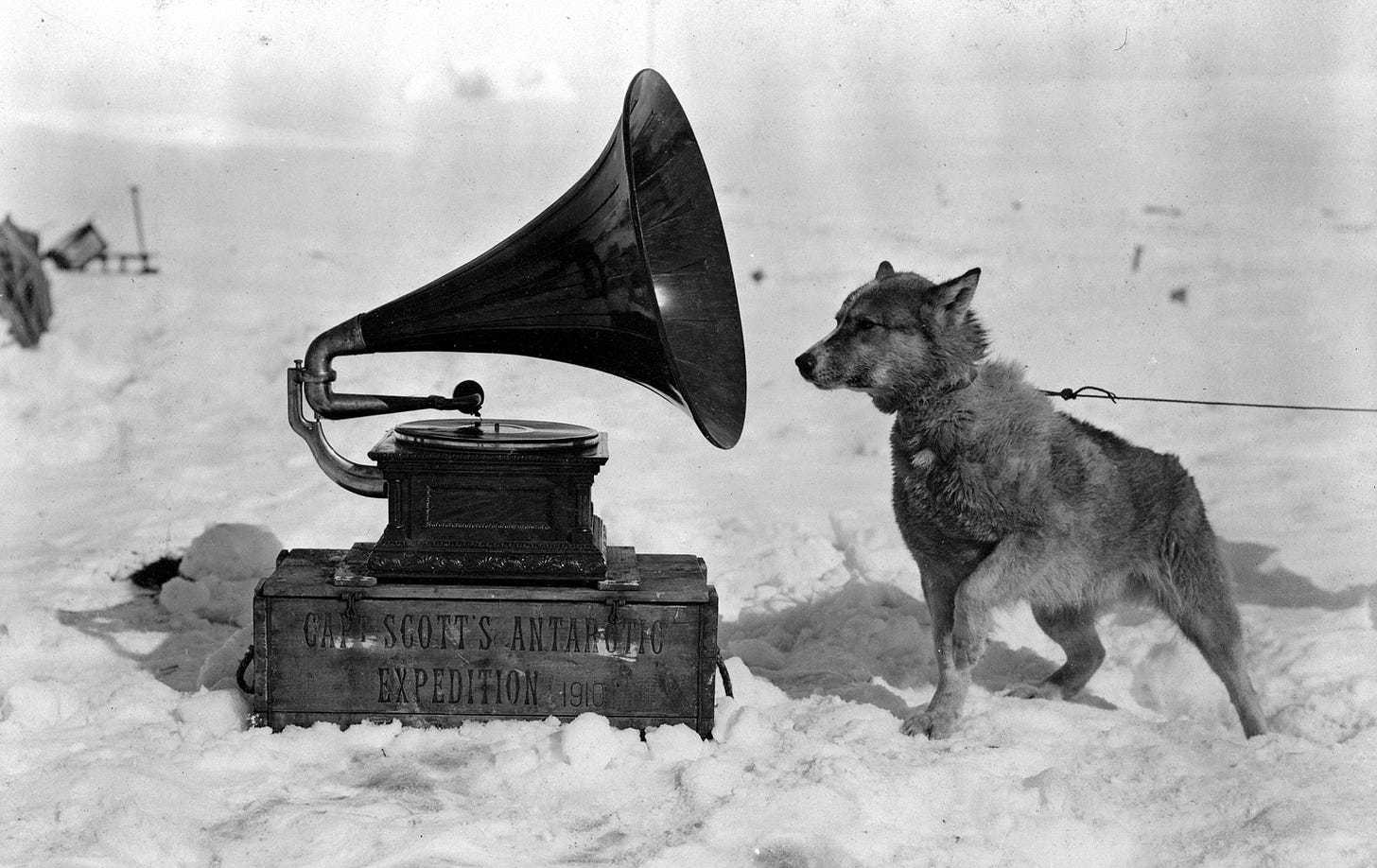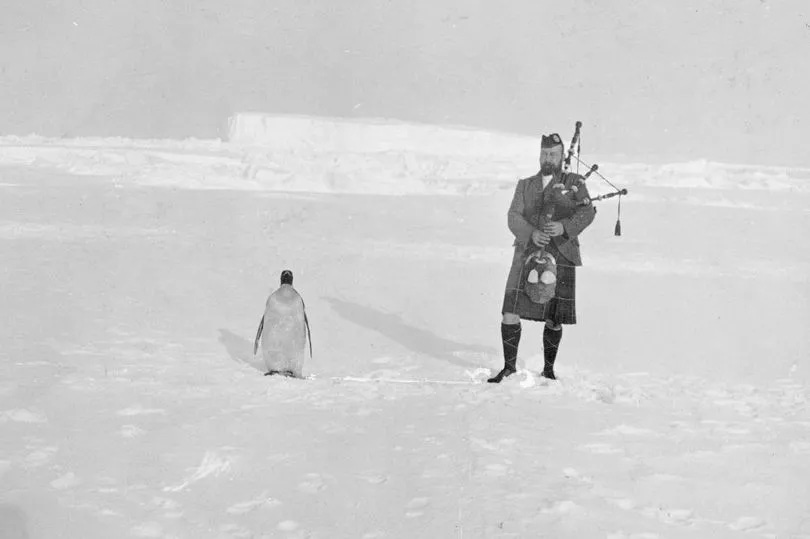The first Antarctic field recording
The perculiar story of a seal, a piper and a phonograph, accounts of early recordings made in Antarctica offer a parable of deleterious intervention in the natural world.
I didn’t intend January to be the Antarctic month on Through Sounds, but it makes sense. While researching for my ice cores audio documentary in the autumn, I spent an afternoon in the British Library diverted by a quest to find details of the first sound recordings made in Antarctica. Although not hugely reliable, consensus seemed to point towards the Scotia expedition of 1902, whose logbook I called up from the vaults and spent several hours poring through for evidence of those elusive recordings.
21st September 1903: “As we stood on the top of Delta Island, a gentle, farm-like sound came up to us from the floe, the gurgling throat-sound of the mothers rather resembling the soft cackling of ducks and hens, and the bleating of baby seals like the bleating of lambs, while mixed with this was a gentle lowing like that of oxen far away. These gentle sounds – musical I should call them – were the only ones that broke the silence, as we stood enraptured with the beautiful scene that lay before us.”
William Speirs Bruce had reason to be in a reflective mood. Eleven days earlier, the captain of the Scottish National Antarctic expedition had taken into his care a Weddell seal pup, like the one whose bleating broke the silence on that pale polar evening. Weddell seals were usually high on the Antarctic menu, alongside shags and penguins, but this one Bruce had earmarked for something else. “I am keeping it alive to try for a good half-plate photograph tomorrow,” he wrote on 10th September 1903. “And, if possible, to phonograph its voice, which is very human.”
Alongside the crew and an array of scientific instruments to chart the topography, biology and geology of Antarctica, the Scotia had been furnished with a phonograph and thirty or forty records which were “faithfully ground out” on concert evenings under the starless sky and “seldom failed to arouse applause.” Tales of trips into the endless white are often accompanied by memories of the estrangement of its silence. In his writing on snow, Tim Ingold noted that “wind unaided makes no sound”, and in Antarctica there tends to be a lot of wind and not a lot else. My friend at British Antarctic Survey Dieter Tetzner described the sensation of wind without noise in similar terms: “You can feel a lot of wind, but there's nothing to create sound, and that is very impressive. It's like seeing a car crash but with noise cancelling headphones.” No doubt the music of the phonograph was a welcome relief, familiar and grounding.
[A phonograph was also packed into the hold of Scott’s famous 1910 Terra Nova expedition, as a gift from His Master’s Voice, whose logo the crew had tried to emulate in the snow, seen in the main image of this post.]
As well as the phonograph, the Scotia also welcomed a man named Gilbert Kerr, 32 years old, from Edinburgh, whose job title in the crew list at the front of the logbook was “ordinary seaman, laboratory assistant, piper”. A safe pair of hands who could wield a set of bagpipes to raise the spirits whenever morale was low, a photograph of Kerr in full Highland dress playing the pipes to a penguin became one of the first postcards to be sent from Antarctica. On the crew’s return to Scotland, the bagpipes were given to 1st Edinburgh Battalion of the Royal Scots, where they were played by Piper Anderson during the Battle of the Somme and subsequently lost to the fog of war.
It was not unusual for expeditions in the so-called “Heroic Age” of Antarctic exploration to employ the services of musicians. There is a woodcut of Japanese musician Keiichi Tada playing the shakuhachi (a traditional Japanese bamboo flute) to crew of the Japanese Antarctic Expedition in 1910–1912, while the Terra Nova also made room for Russian Anton Omelchenko who brought with him a balalaika (a long- necked lute with a triangular body).1 What was more unusual was that the phonograph which William Speirs Bruce and the Scotia expedition of 1902 had on board came with a handful of blank shellac discs and, like Bruce’s half-plate camera, the intention to record and contribute to the sum of human knowledge about Antarctica. And so it came to be that Gilbert Kerr the piper ended up playing second fiddle, so to speak, to the seal pup that Bruce had adopted on the 10th September 1903.
13th September 1903: “He yawns with a prolonged sighing note, and cries “Ma” remarkably like a baby,” noted Bruce, who had taken to the creature so much as to christen him “Phoca”. He details a laborious evening routine whereby Bruce would feed Phoca powdered milk by spoon - first Nestlé and then non-Nestlé varieties, as the former was not to Phoca’s taste. It was a task which became increasingly difficult as the seal grew.
19th September 1903: “She is becoming quite a pet. I like her very much, in spite of the fact that she has bitten me four times on my left arm and both hands, in her effort to resist feeding, which is, after all, entirely a violent operation.”
Earlier that day, after several false starts, Bruce finally managed to make the phonograph recording he had been aiming for. “Before feeding her in the evening we got her to speak in the phonograph,” he wrote. “The result was remarkably successful.” The entry continues, somewhat dryly: “The piper also played a selection for another record; that result was also satisfactory.” Not exactly a glowing review for poor old Gilbert Kerr.
I have tried to find evidence of this recording of Phoca beyond the Scotia’s logbook, but so far been unsuccessful. However, like many of the natural sound recordings made over the following century, there is something both hopeful, elegiac and destructive about this story.
The following day, on 20th September 1903, Phoca was beset by violent convulsions “evidently arising from abdominal troubles” - almost certainly as a result of the milk he had been fed by Bruce and the crew. Despite two additional doses of potassium bromide, “she slept all the afternoon, but her heart was getting weaker, and at 7.35pm the poor creature was dead,” Bruce wrote. The first natural sound recording made in Antarctica was also the last thing that poor Phoca gave to the world. Something taken, something lost. When Bruce stood at the top of Delta Island the next day, he would have been all the more sensitive to the bleating of baby seals rising up from the floe beneath.
The rest of Bruce’s accounts of the Scotia expedition, which returned to Scotland in 1904 having become trapped in pack ice in the Weddell Sea, is peppered with accounts of photographs and phonograph recordings. One more stands out.
19th October 1903: “Brown, Rossie, Willie, and cook went out and got a crateful of penguins for the phonograph, which I tried for them in the evening, as well as for the piper. It was not very successful but afterwards I shaved a record, and produced a much better result, though the penguins were less lively.”
And then a few lines later:
“The piper is becoming a proficient skinner.”
See Carolyn Philpott - “The sounds of silence: music in the Heroic Age of Antarctic exploration”




one can only imagine how strange that experience must have been for the penguin!!!
Phantastic piece! So informative and funny.